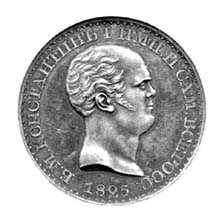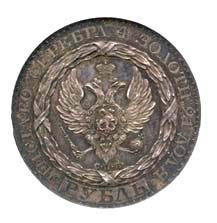

LEGENDARY CONSTANTINE RUBLE SETS NEW RECORD IN THE NEW YORK SALE AUCTION VIII AS THE
WORLD’S MOST EXPENSIVE NON-U.S. COIN
NEW
YORK – Living up to its pre-sale fanfare, even outdoing it, Russia’s epic
rarity, the Pattern 1825 plain edge Constantine Ruble hammered for $525,000,
January 15 at the New York Sale Auction VIII. This lofty price tag has earned
the coin the august title of most expensive non-U.S. coin ever sold in auction.
The Ruble was the star highlight in the 434-lot Sale of Rare Russian Coins and
Medals conducted by Dmitry Markov Coins & Medals, New York; Baldwin’s
Auctions Ltd., London; and M & M Numismatics Ltd., Washington, D.C.
Only
one of two known with a plain edge (between both varieties, there are a total
seven specimens known), the Constantine Ruble, lot 776 in the sale, was
estimated at $500,000. Grading Choice Brilliant Uncirculated and certified PF62
by NGC, the piece was previously sold at the Hess-Divo Sale in April, 1999, and
purchased then by California-dealer M.L. Teller. Nearly five years later, amid
a highly-charged and coin-fevered atmosphere in the Norse Suite of New York’s
Waldorf Astoria, the coin opened at $400,000.
It closed to sighs and exclamations at the historic figure of $525,000.
“We
are ecstatic about this new record,” said Dmitry Markov, one of the Sale’s
principals. “You have to bear in mind that this coin, as famous, rare and
romantic as it is, is still a regular-size Crown, not a gigantic ancient
Dodekadrachm or hockey-puck sized Mughal Gold coin, so the price seems even a
greater statement. It is a very healthy thing not only for Russian, but for all
World coins.”
Long
the most romanticized coins in Russian numismatics, the Constantine Ruble was
struck for a Tsar who never was. When Tsar Alexander I died in 1825, it was
taken for a fact that Grandduke Constantine Pavlovich, the Russian viceroy of
Poland, was the new Tsar. Russia’s finance minister Egor Kankrin called for the
mint to immediately produce pattern portrait Rubles of Constantine.
Constantine, however, had secretly renounced his rights as heir in a manifesto
two years before. The Manifesto was made known after a fortnight, and
Constantine’s brother Nicholas was proclaimed Tsar. Fearing his production of the pattern would appear as lese
majeste, Kankrin ordered all work stopped and had all evidence impounded and
sealed away.
“Constantine
Ruble aside,” said Markov, “the sale itself was a great success, showing that
Russian coins are consistently strong. High-grade and pattern coins did very
well. Lot 714, a Pattern Novodel portrait Ruble of Alexander I, n.d. (1806) by
Leberecht (Bit H644), for example, grading Choice BU and estimated at $15,000,
bought $23,000. While lot 715, a Pattern Novodel Alexander Ruble, n.d. (1810)
by Lyalin (Bit H653) in Choice BU, sold for $17,000, 70 percent over estimate.
The sale’s large run of Peter the Great Rubles also
proved very popular with bidders. Even with traces of a loop, a Rare 1710 Ruble
in VF, for example, realized $4,500, fifty percent over estimate. Other
highlights included an Uncirculated 1756 Tsarina Elizabeth Gold 10 Rubles, and
a Peter III 1762 Gold 5 Rubles in AU, both selling for 20 percent over estimate
at $9,000 each. The total realized for the sale was $ 1,039.489.00 according to Markov.
For
a complete prices realized, the sale may be viewed on one of the websites: www.russian-coins.net and www.sixbid.com. For further information,
please contact: Dmitry Markov Coins & Medals, P.O. Box 950, New York, NY
10272
###